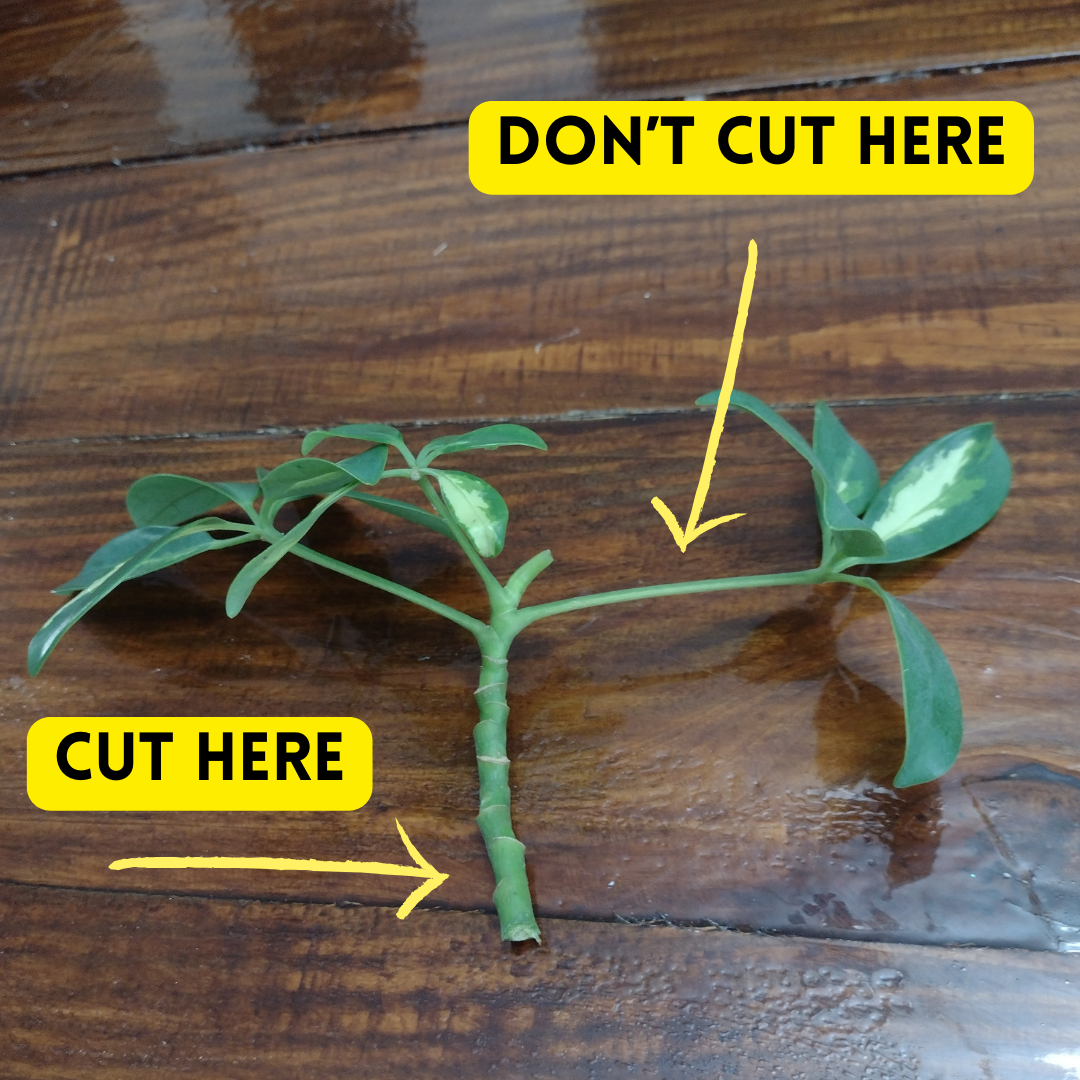Ever wondered how you can multiply your beloved umbrella plant? Well, you’re not alone. And the good news is, umbrella plants can be pretty easy to propagate!
As with most plants, there are several propagation methods that work, although water propagation has been shown to be the easiest, most beginner-friendly propagation method with the highest success rates. That being said, here’s what we’re going to cover today…
- Understanding Umbrella Plant Propagation
- Different ways to propagate umbrella plants
- Step-by-step guide to water propagation
- Step-by-step guide to soil propagation
- An overview on how to care for your new baby plant!
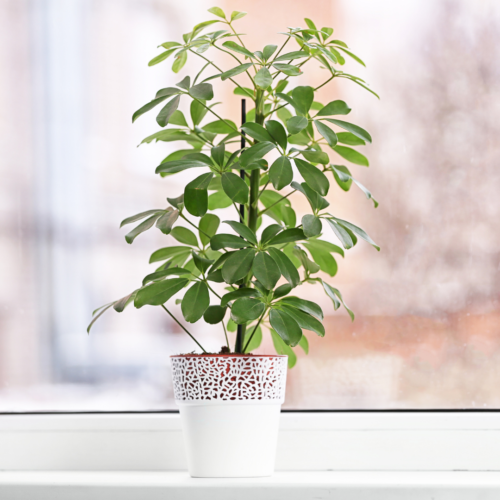
Understanding Umbrella Plant Propagation
Propagation is the scientific term for the process of creating new plants from an existing one. In simpler terms, it’s like giving birth to a new plant, but one that has the exact same DNA as the parent plant. This helps to maintain any desireable qualities (like variegation) that the mother plant may have. And the good news is that umbrella plants, also called dwarf umbrella plants or schefflera actinophylla, are considered one of the easier plants to propagate.
Propagation can be accomplished using various parts of the parent plant. These are:
- seeds (though this doesn’t produce an exact clone)
- stem cuttings
- leaf cuttings
- root cuttings
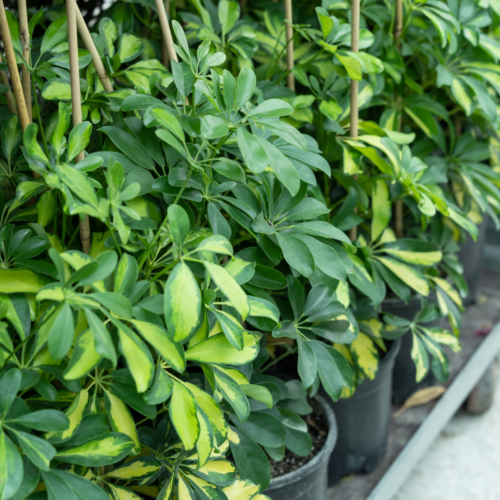
Today we are going to focus on getting schefflera cuttings from the stem portion of the plant since that is the easiest, most reliable way to get cuttings.
*Note: Umbrella plant sap contains calcium oxalate crystals, which can cause a mild allergic reaction to some individuals when it comes in contact with their skin. Please be sure to use gloves while taking cuttings to help keep yourself safe!*
*Note #2: This post contains affiliate links, which if purchased I will receive a small portion of the profit at no extra cost to you. This allows me to keep providing awesome information to y’all!*
Ways to Propagate Umbrella Plants
Different methods of propagation can be used for umbrella plants, and it all depends on what works best for you. Although water propagation is often mentioned as the easiest way to propagate umbrella trees (and it boasts a higher success rates), other methods like soil propagation or air layering are also worth exploring and can be fun to try out! For example, some people have told me that they have amazing success with soil propagation and will never go back to water propagation! Because of this, I would recommend you try a few different methods yourself to see which method you find the easiest and most successful for your dwarf schefflera.
Here’s a bit about the different (and most common) types of propagation:
Water Propagation
Water propagation involves cutting a healthy branch from the plant and submerging it in a glass of water until roots begin to form. Then once roots form, you either transition your cutting into soil, or you grow it hydroponically.
Soil Propagation
Soil propagation has you plant your cutting directly into the soil. This saves a step, since water propagation requires the cutting to root in water and then be transitioned into soil, whereas soil propagation is in the soil to begin with and doesn’t need the extra transition phase.
Air Layering
Air layering, on the other hand, is a bit more complex than the other two methods as it requires you to make a cut on the plant, then cover the cut section with wet moss until roots sprout. The benefit to air layering is that it keeps the cutting attached onto the parent plant until roots are formed, allowing it to get more energy from the parent plant while it is growing its roots. However, it is more difficult to master the correct technique of cutting the stem at the right depth, wrapping the moss around the stem portion, and keeping it moist enough to stimulate root growth. This is why it can have the lowest success rates for beginner propagators. However, those with experience can have great success with air layering.
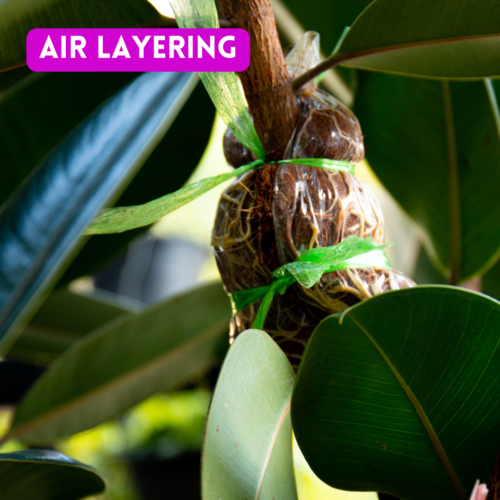
It’s important to remember that these methods require patience and constant monitoring, ensuring that the conditions are perfect for the cuttings to root and grow into a new plant. In the next sections, we will focus on the step-by-step guide of water propagation and soil propagation, then discuss the challenges you might face and how to address them.
How to Water Propagate your Umbrella Plant
1. Select a Healthy Cutting
Choosing a healthy and robust stem cutting is the essential first step in umbrella plant propagation. Look for stems that are firm, green, and free from any signs of disease or pests. It is also best to propagate during the plant’s growing season from spring to early fall.
A good cutting should be about 4-6 inches long with several healthy leaves at the top. Make sure that you get some of the main stem of the mother plant and not just part of the leaf stem. If you think of it like a tree, its like umbrella plants have very long leaf stems. You don’t want just a leaf stem. You need part of the branch! This plant stem is essential. If you only have a leaf stem, then your cutting won’t root.
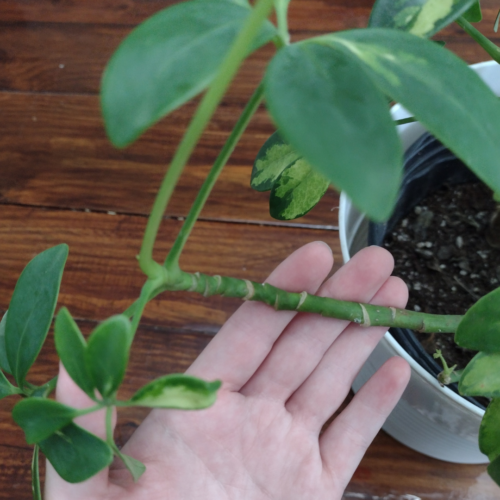
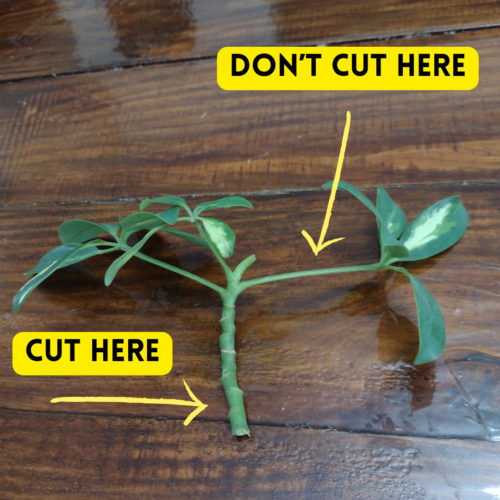
2. Use a Clean, Sharp Cutting Tool
To minimize damage and avoid spreading disease, always use a clean, sharp cutting tool when taking your stem cuttings. Consider disinfecting your tool with rubbing alcohol before each use. Then simply cut off your cutting! 😉
3. Let the Cut Seal
Umbrella plants aren’t as picky as other plants with this step, but you do still want to make sure that you let your cutting seal for a few hours for best results. This is done by leaving your cutting out in a cool, dry location and out of direct sunlight for a few hours. This will help to avoid rotting of the bottom portion of your cutting.
If your cuttings are consistently turning brown and mushy on the bottom instead of growing roots, then you aren’t letting your cut seal enough before placing it in water!
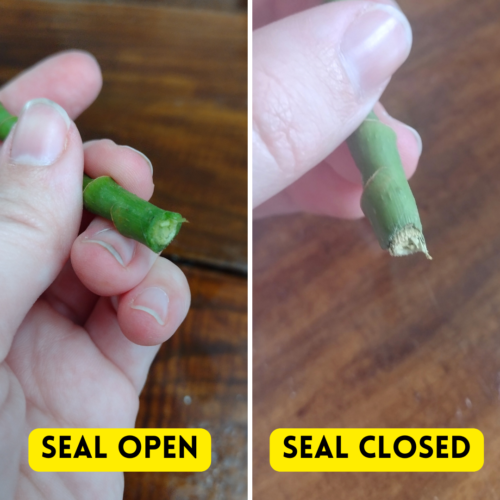
4. Place in Water
Place your cutting cut-side down into a container of water. Try to keep the leaves dry. I’ve heard some people say that they only use distilled water for propagating their cuttings, but with the umbrella plant I have personally used tap water and have never had an issue.
I have also heard some people add a few drops of SuperThrive to their water. Once again, I have never personally done this (going to experiment with it here soon!) but it sounds like it could be beneficial to your plants!
Then, make sure that you change out your water every week or so to keep bacteria from growing. If you start to see any bacterial or algae growth, you can clean out your container with a light bleach solution, then rinse thoroughly with water (several times!) and replace with clean, fresh water. Oh, and please be sure to remove your cutting during this time… bleach will not do good things to your little plant!
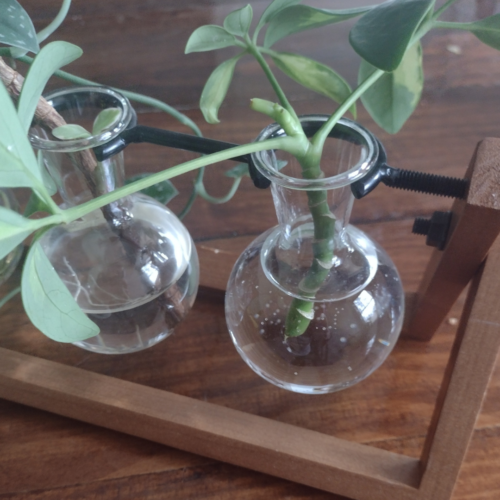
5. Create the Right Environment
Umbrella plants prefer warm temperatures and a humid environment, especially during the propagation stage. They are tropical plants, after all! Consider using a propagation box, a clear plastic bag, or simply mist your cuttings regularly to maintain high humidity levels. Just make sure that if you are increasing humidity with a bag or a box, that the sides do not touch the leaves. This could cause the leaves to turn brown and get bacterial spots.
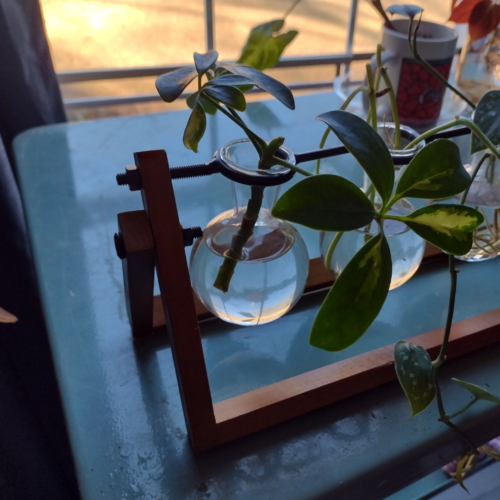
6. Be Patient
Propagation isn’t an overnight process. It can take a few weeks for stem cuttings to develop roots. You will begin to see the cut end form some white bubbly tissue. This is a good sign! This is where the cells are undifferentiating, to later redifferentiate into root cells. Basically it’s where your new roots are going to form. So don’t brush or scrub this off!
This bubbly white tissue is different from slimy gunk. Slime is usually not the greatest and it’s best if you see it to gently rinse off as much as you can and to change out your water more frequently. It’s okay if not all of the slime comes off. It’s more important that you be gentle while rinsing off any excess.
Also note that yellow leaves does NOT mean that your plant is dead. Check the stem for a real indication of life. If the stem is still green and full, then you are good. If your stem starts to shrivel and/or your cut end begins to turn brown and mushy, then you will need to start over with a new cutting.
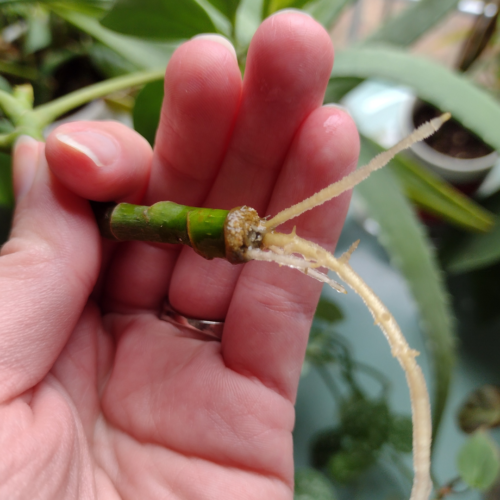
7. Place in Soil
Once your cutting has formed a good set of roots then it is time to plant it into soil (and not just one or two roots, I mean a root system where the roots are branching!).
To put your cutting in soil, simply get a small, well-draining pot and place the soil loosely around the roots. Then compact the soil around the root system to hold it in place. Your roots need to have good contact with the soil, but you also need to be gentle while putting them in soil for the first time!
Once your cuttings are in your pot, make sure that you keep the soil evenly moist. This will be a bit more wet than you would normally keep your umbrella plant. It is just during the transition from straight water into soil. In a week or so you can start letting it dry out more and more between each watering. This is how you are going to help it successfully transition from water to soil.
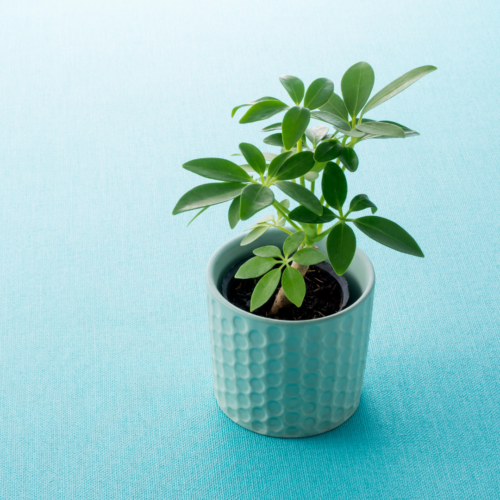
8. Regularly Check for Pests and Diseases
Regularly inspect your cuttings and the mother plant for signs of pests and diseases. Spider mites and scale insects are the main pests that affect schefflera. Early identification and treatment can prevent major plant health problems down the road!
How to Propagate your Umbrella Plant in Soil
To propagate your umbrella plant in soil, follow the above directions for taking the right cutting and using a clean, sharp cutting tool.
Use a small pot or container that has drainage holes and fill it with an airy, moist soil mixture (something with a lot of organic material such as peat moss, combined with sand or perlite to increase the drainage). Then make a finger-sized hole into the soil. By pre-making the hole, it will decrease the amount of rooting hormone that rubs off when placing it in the soil.
Next, dip the end of your cutting into rooting hormone, shaking off the excess powder, and place it into the soil.
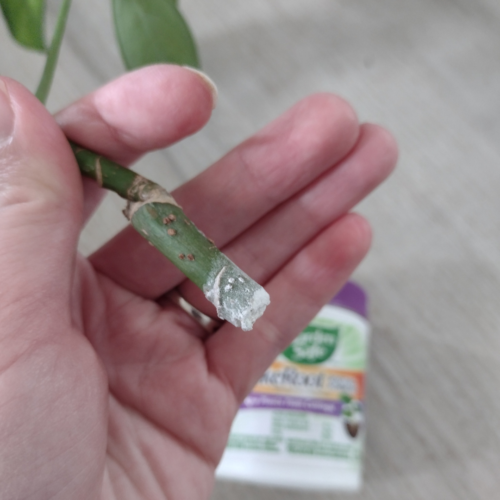
Keep the soil consistently moist and try to keep it in a humid environment. Consider keeping it in a propagation box or add a clear plastic bottle or bag around it. This will help to increase the humidity levels.
Another tip… if you are struggling with low success rates with your soil propagation, consider using a soil heating mat. These mats keep your soil around 70 to 80 degrees fahrenheit, which will help stimulate your plant’s roots to start forming. Here is an affiliate link to the soil heating mat that I personally recommend. (Thanks for your support!)
Also, please resist the urge to tug on your cuttings to check for roots. This will tear your small, fine roots. Instead, look for new growth as an indication that roots are forming. This is the best way to keep your baby roots intact! Then, once you start seeing some new growth, consider incorporating a slow-release fertilizer to help it have the nutrients that it needs to support plenty of awesome new leaves!
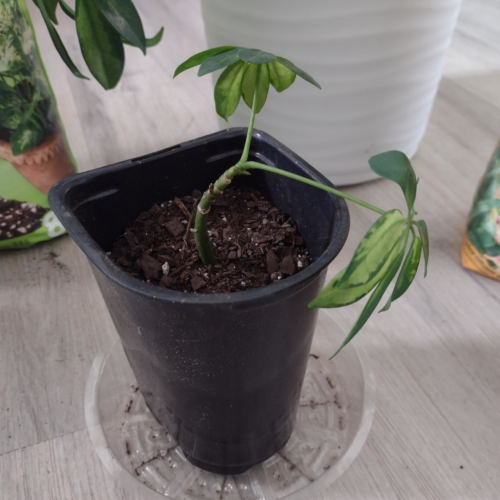
Caring for Your Propagated Umbrella Plant
I wanted to note that once you’ve propagated your dwarf umbrella tree, it’s crucial to care for it properly to ensure its survival and growth. As umbrella plants prefer high humidity levels, it’s a good idea to try to increase the humidity around your newly propagated plant until it develops an extensive root system. This can be done through placing a glass or plastic dome over it, by misting it daily, or by placing it in a room that has higher humidity, such as a bathroom or a kitchen. Bright, indirect light is also ideal. Avoid low light conditions as this can cause your new plant’s growth to slow or to even stop completely.
Keep an eye out for small webbing in the leaf joints, which can be a sign of spider mites. These little guys are a common pest of schefflera plants and they can cause an otherwise correctly taken cutting to still fail. If you have spider mites, then don’t propagate your plant. First treat your plant with a mild insecticidal soap or horticultural oil until all of the insects are gone. After all, an unhealthy plant will have a harder time during propagation.
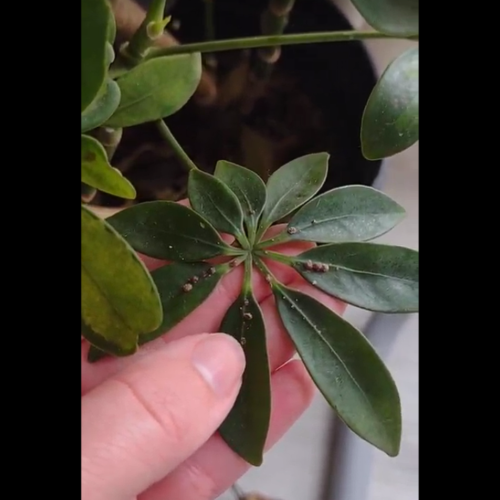
Continue to regularly check your plant for signs of distress such as yellowing leaves or drooping growth. These signs could indicate root rot from too much water, inadequate lighting, or pest infestations.
For more in-depth care information for your schefflera houseplant, check out my post on Umbrella Tree Plant Care!
Conclusion
That’s it for our guide to umbrella tree propagation! I hope you have great success in turning your mature plants into lots of new little house plants! And for more houseplant inspiration, check out my post on the 31 Best Indoor Plants!
Happy Digging!
Umbrella Plant Propagation FAQs
How long does it take for an umbrella plant to root in water?
Rooting time depends on the conditions and health of the original plant, but most umbrella plant cuttings start developing roots in water within 2-4 weeks. When the roots are about an inch long, they’re ready to be transferred to soil, though I usually wait until the roots are about 3 inches long to be safe!
What part of the umbrella plant is best for propagation?
The best part for propagation is typically a healthy stem cutting. You’ll want to cut just above a leaf node (making sure to get a portion of the plant stem, not just the leaf stem), and the cutting should have at least two sets of leaves. This is the most effective method for ensuring successful propagation.
Can I propagate an umbrella plant in soil?
Yes, you can propagate an umbrella plant in soil. While it may not provide the same success rate as water propagation, it can be done. Be sure to keep the soil moist and place the cutting in a warm, brightly lit location out of direct sunlight. Also consider using a heating mat if you want to boost your success rates with soil propagation.
How do I know if my umbrella plant cutting is rooting?
You can observe the bottom of your cutting in water to see if small roots are beginning to sprout. If rooting in soil, you may notice new growth on the stem or leaves, indicating successful rooting. Remember, patience is key, as it sometimes takes young plants a few weeks before they show any progress. And be sure to never pull on your soil cuttings to check for roots. This can damage any fine, small roots that may have already formed!

